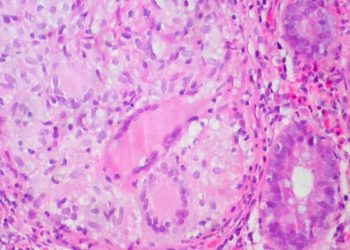2 Minute Medicine Rewind January 23, 2017
Perioperative respiratory adverse events (PRAE) are among the most critical incidents encountered in pediatric anesthesia, with infants particularly at risk. In addition to having small airways, infants have a low oxygen reserve and lose their protective airway reflexes under general anesthesia. Endotracheal tubes (ETT) are able to reliably secure the airway and protect patients from aspiration. Laryngeal mask airways (LMA), while easier to insert and associated with less mechanical stimulation of the airway, are often regarded as less secure in infants. Recent research, however, shows that the use of LMAs is associated with reduced PRAE compared to ETT in children >1 year old. In this randomized controlled trial, 181 infants age 0-12 months undergoing general anesthesia for minor elective procedures were randomized to receive an LMA or ETT to evaluate the effect of these devices on the incidence of PRAE in infants. Based on an intention-to-treat analysis, PRAE occurred in 53% of infants in the ETT group, compared to 18% in the LMA group (RR 2.94, 95% CI 1.79 to 4.83, p<0.0001). In addition, laryngospasm and/or bronchospasm were observed in 19% of patients in the ETT group, compared to 4% in the LMA group (RR 5.30, 95% CI 1.62 to 17.35, p=0.002). This study therefore shows that the use of LMAs in infants undergoing minor elective procedures is associated with fewer PRAE compared to ETTs.
Osteoarthritis (OA) is a leading cause of pain and disability. While most OA interventions take place at the patient level, there is evidence to suggest that combined patient and provider interventions result in improvements in physical function. In this cluster randomized trial, 537 outpatients with symptomatic hip or knee OA were randomized to receive usual care, patient-based, provider-based, or patient-provider interventions to examine effects on pain, physical function and depressive symptoms. The patient-based behavioral intervention took place over 12 months, with a focus on physical activity, weight management and cognitive behavioral strategies for managing pain. As part of this intervention, telephone calls were scheduled twice per month for the first 6 months, and then monthly for the last 6 months, delivered by a counselor with training in OA and behavior change. The provider intervention was based on patient-specific OA treatment recommendations, including referral to a physical therapist, referral for use of a knee brace, referral to a weight loss program, administration of intra-articular injections, the use of topical and/or systemic non-steroidal anti-inflammatory drugs, and orthopedic evaluation for joint replacement surgery. Researchers found patients in the patient-provider intervention group did not have greater improvements in pain scores between baseline and 12 months when compared to the patient-based or provider-based intervention groups (p=0.69). In fact, no significant improvements were observed in any of the intervention groups when compared to usual care. In addition, no differences were noted with respect to objective physical function or depressive symptoms at 12 months in any of the intervention groups when compared to usual care. This study therefore shows that similar pain-related outcomes are likely achieved with patient-, provider-, and patient-provider based interventions for OA.
Human papillomavirus (HPV) infection is the most commonly sexually transmitted infection in the US, with approximately half of new infections occurring before the age of 24. While HPV is most commonly implicated in the development of cervical cancer, HPV-related penile, anal and oropharyngeal cancers are also seen in men. And, although male HPV vaccination programs have been available since 2009, the male genital HPV infection prevalence is still unclear, with vaccination rates among men remaining low throughout the US. In this cross-sectional study, the authors report on the prevalence of genital HPV infection among 1868 US male adults, age 18 to 59. As part of this study, penile swab specimens were collected and HPV genotyping was performed by polymerase chain reaction (PCR) amplification. Researchers found that the overall genital HPV infection prevalence was 45.2% (95% CI: 41.3% to 49.3%) and followed a bimodal pattern, with a peak in infection among men age 28-32 years and 58-59 years. Based on DNA testing, the prevalence of infection with at least 1 high-risk HPV subtype was 25.1% (95% CI 23.0% to 27.3%). Among vaccine-eligible men, the HPV vaccination coverage was 10.7% (95% CI 7.8% to 14.6%). This study therefore shows that the estimated prevalence of genital HPV infection in men is widespread, with low vaccination coverage in those that are vaccine-eligible.
Ocrelizumab versus placebo in primary progressive multiple sclerosis
Patients affected by primary progressive multiple sclerosis (MS) experience gradual worsening of neurologic disability from the time of symptom onset. This course of disease is unlike that seen in patients with relapsing-remitting and secondary progressive forms of MS. Researchers have established that B cells play an important role in the pathogenesis of MS and are present in meningeal inflammation linked to cortical demyelinating and neurodegenerative pathology. Ocrelizumab is a monoclonal antibody that selectively depletes B cells expressing the CD20 antigen, demonstrating some benefit in the delay of MS progression in younger patients. In this randomized controlled trial, 732 patients were randomized in a 2:1 ratio to receive ocrelizumab or placebo to investigate the efficacy and safety of ocrelizumab in patients with primary progressive MS. Researchers found that the percentage of patients with 12-week confirmed disability progression was 32.9% with ocrelizumab, compared to 39.3% with placebo (HR 0.76, 95% CI 0.59 to 0.98, p = 0.03). At 24-weeks of follow-up, the percentage of patients with confirmed disability progression was 29.6% in the ocrelizumab group versus 35.7% in the placebo group (HR 0.75, 95% CI 0.58 to 0.98; p = 0.04). The authors also found that by week 120, patients in the ocrelizumab group were less likely to demonstrate worsened physical function as per a 25-foot walk test (p = 0.04). These patients also had a decreased total volume of brain lesions on magnetic resonance imaging (MRI) imaging (p<0.001). This study therefore shows that, among patients with primary progressive MS, the use of ocrelizumab is associated with lower rates of clinical and MRI progression when compared to placebo.
Appendectomy and cholecystectomy are among the most common non-obstetrical surgeries performed in pregnant women. This poses a risk to the fetus, including loss of pregnancy before viability, preterm labour, preterm delivery and fetal death. Currently, there is insufficient data to allow for risk stratification, preventative measure implementation and maternal counseling concerning anticipated outcomes for non-obstetrical surgery. In this cohort study, 19,926 women were followed up to identify risk factors for adverse obstetrical outcomes after appendectomy and cholecystectomy during pregnancy. Researchers found that cervical incompetence (OR 24.29, 95% CI 7.48 to 78.81), preterm labour during current pregnancy (OR 18.34, 95% CI 4.95 to 67.96), vaginitis or vulvovaginitis (OR 5.17, 95% CI 2.19 to 12.23) and sepsis (OR 3.39, 95% CI 2.08 to 5.51) were significantly associated with adverse obstetrical outcomes. This study therefore shows that adverse obstetrical outcomes may be predicted, and possibly addressed, in women undergoing non-obstetrical surgery.
Image: PD
©2017 2 Minute Medicine, Inc. All rights reserved. No works may be reproduced without expressed written consent from 2 Minute Medicine, Inc. Inquire about licensing here. No article should be construed as medical advice and is not intended as such by the authors or by 2 Minute Medicine, Inc.







